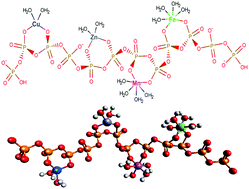Isolated Saccharomyces cerevisiae vacuoles contain low-molecular-mass transition-metal polyphosphate complexes†
Abstract
Vacuoles play major roles in the trafficking, storage, and homeostasis of metal ions in fungi and plants. In this study, 29 batches of vacuoles were isolated from Saccharomyces cerevisiae. Flow-through solutions (FTS) obtained by passing vacuolar extracts through a 10 kDa cut-off membrane were characterized for metal content using an anaerobic liquid chromatography system interfaced to an online ICP-MS. Nearly all iron, zinc, and manganese ions in these solutions were present as low-molecular-mass (LMM) complexes. Metal-detected peaks with masses between 500–1700 Da dominated; phosphorus-detected peaks generally comigrated. The distribution of metal:polyphosphate complexes was dominated by particular chain-lengths rather than a broad binomial distribution. Similarly treated synthetic FeIII polyphosphate complexes showed similar peaks. Treatment with a phosphatase disrupted the LMM metal-bound species in vacuolar FTSs. These results indicated metal:polyphosphate complexes 6–20 phosphate units in length and coordinated by 1–3 metals on average per chain. The speciation of iron in FTSs from iron-deficient cells was qualitatively similar, but intensities were lower. Under healthy conditions, nearly all copper ions in vacuolar FTSs were present as 1–2 species with masses between 4800–7800 Da. The absence of these high-mass peaks in vacuolar FTS from cup1Δ cells suggests that they were due to metallothionein, Cup1. Disrupting copper homeostasis increased the amount of LMM copper:polyphosphate complexes in vacuoles (masses between 1500–1700 Da). Potentially dangerous LMM copper species in the cytosol of metallothionein-deficient cells may traffic into vacuoles for sequestration and detoxification.



 Please wait while we load your content...
Please wait while we load your content...